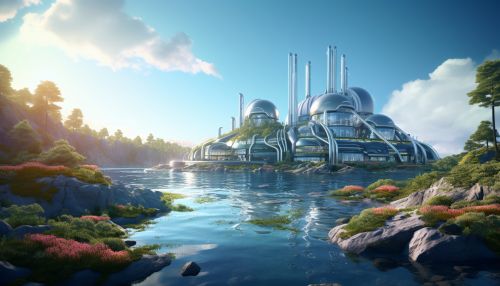Osmotic Power
Introduction
Osmotic power, also known as salinity gradient power, is a form of renewable energy that is derived from the difference in the salt concentration between seawater and river water. Two practical methods for this are reverse electrodialysis (RED) and pressure retarded osmosis (PRO). Both methods rely on osmosis with membranes. The key waste product is brackish water. This byproduct is the result of sea water and fresh water mixing and can be used in aquaculture or released back into the sea.


Osmosis and Osmotic Pressure
Osmosis is a natural process wherein a solvent moves from an area of low solute concentration, through a membrane, to an area of high solute concentration. The driving force for this process is the chemical potential (a form of potential energy that can be harnessed to do work) which has a differential across the membrane. This process can continue until the concentrations are equal on both sides of the membrane, or until the osmotic pressure equals the opposing pressure. If the membrane is impermeable to the solute, then the differential in chemical potential of the solvent (water in the case of osmotic power) across the membrane drives the water across the membrane to the high solute side.
Reverse Electrodialysis (RED)
Reverse electrodialysis (RED) is a technology for generating electricity by mixing fresh river water and salty sea water in large power cells designed for this purpose. The principle of RED is that a difference in salt concentration can be used to generate an electric current. The technology is still in an early phase of development, but initial tests have shown promising results.
Pressure Retarded Osmosis (PRO)
Pressure retarded osmosis (PRO) is the other method used to generate osmotic power. In this method, seawater is pressurized and then passed through a semi-permeable membrane. When freshwater is also passed through the membrane, the difference in the salt concentrations on the two sides of the membrane causes the water to move from the freshwater side to the seawater side. This movement of water is then used to power a turbine which generates electricity.
Environmental Impact and Sustainability
Osmotic power is a renewable and sustainable form of energy as it exploits the natural process of osmosis. It does not produce any harmful byproducts or emissions, making it an environmentally friendly option. The main byproduct, brackish water, can be utilized in aquaculture or safely released back into the sea. However, the construction and operation of osmotic power plants can have environmental impacts, including the potential for harm to marine and river ecosystems through the intake and discharge of water.
Potential and Challenges
The global potential of osmotic power is considered to be enormous. However, the technology is still in its early stages of development, and there are many technical challenges to be overcome, including the development of more efficient membranes and energy recovery systems. The cost of energy production is currently high compared to more established forms of renewable energy. Further research and development is needed to make osmotic power a commercially viable option.
